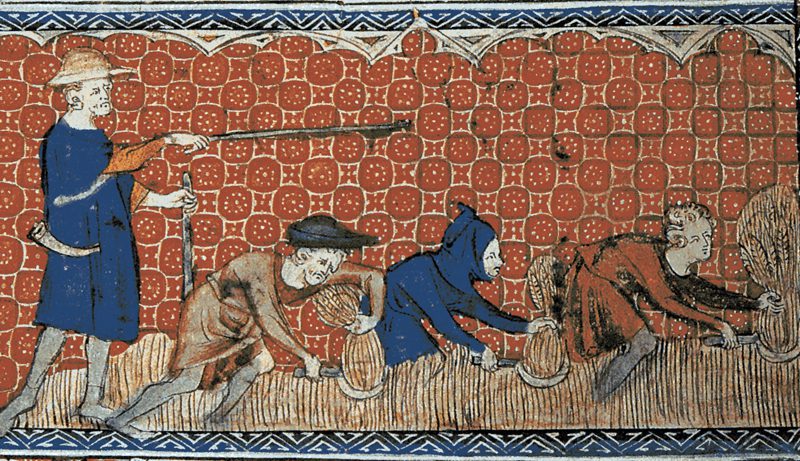
The above image of harvest comes from a 14th century manuscript identified as Queen Mary Psalter (fol.78v), c.1310; known as Queen Mary Psalter because it was confiscated by the Tudor Queen Mary in the 1550s. It shows three serfs cutting what appears to be wheat using sickles, this prior to stooking. The fourth figure is managing, rather than working, and is probably a reeve, that is a farm manager employed by a monastery or manorial lord. The two sticks he holds are of uncertain purpose, but the horn is probably a sounding horn to sound time for a 14th century tea-break rather than a drinking horn. It is interesting that three of the figures have head coverings of various sorts, probably to protect them from the summer sun. Their bare knees must have been torn to shreds by the stubble stalks. They appear to be cutting so as to leave lengthy straw stubble; modern strains of wheat, barley and oats have been developed to seed on shorter stalks. The stubble would have been left fallow over the winter.
Yesterday spent a few hours at Withernsea mostly walking with the dog on the beach which was very pleasant. Driving through Holderness I would estimate that about 50% of the fields of wheat and barley have already been harvested, that before August. This, of course, is a result of the endless warm, dry weather conditions this spring and summer. Before harvesting a sample of seed is tested for water content, anything over 20% is too wet to harvest, clearly at the moment moisture content is well below that, probably below 10%.
Today’s ‘fields of gold’, a rather romantic way of describing fields of dead annual grass, are uniformly uncluttered by weeds, an example of control over Nature achieved by persistent spraying. The fields above being harvested must have contained many non-cereal seeds, medieval bread was very course by modern standards, but natural.